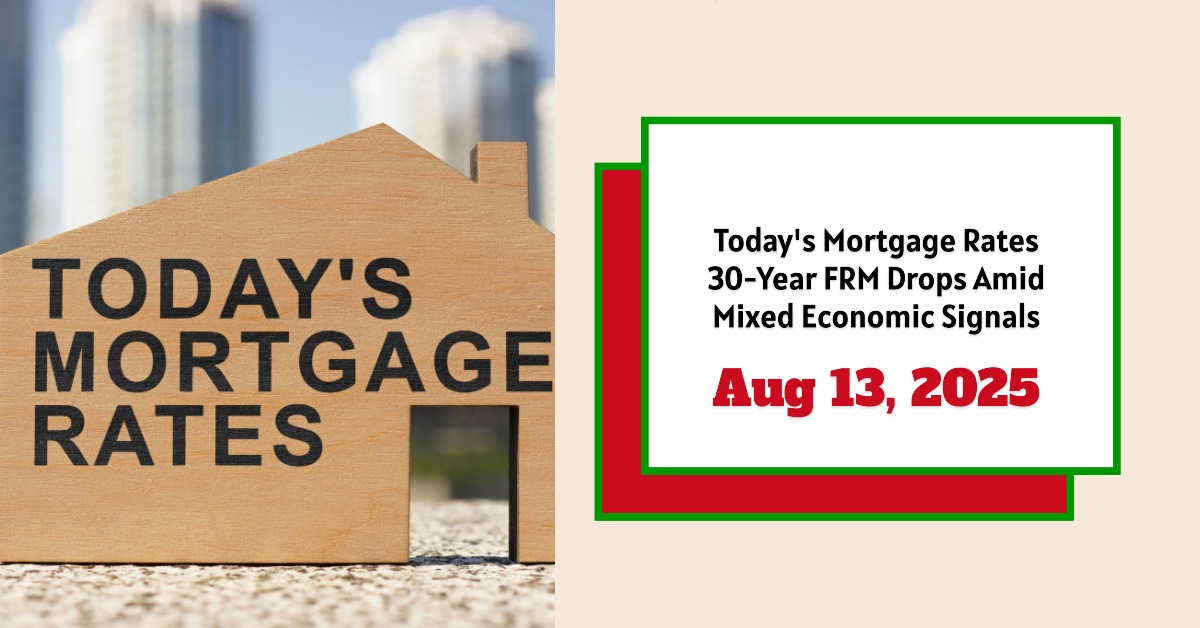As of August 13, 2025, mortgage rates today show a moderate decrease in the 30-year fixed mortgage rate to 6.67%, down 2 basis points from the previous day and 1 basis point lower than last week. Conversely, 15-year fixed rates have inched slightly upward to 5.79%, while 5-year ARM rates have fallen to 7.29%. Refinance rates for 30-year fixed loans also dropped to 6.93%, indicating some easing for homeowners looking to refinance, though other refinance options saw mixed movements. This dynamic reflects broader economic uncertainty influenced by inflation pressures and Federal Reserve policy outlooks.
Mortgage Rates Today – August 13, 2025: Slight Dip in 30-Year Fixed Rates Amid Mixed Economic Signals
Key Takeaways
- 30-year fixed mortgage rate today is 6.67%, slightly down from last week’s 6.68%.
- 15-year fixed mortgage rate is 5.79%, showing a minor increase.
- 5-year ARM mortgage rates dipped to 7.29%.
- 30-year fixed refinance rates also fell to 6.93%, down from 6.98% last week.
- Inflation data released recently shows core inflation rising but overall annual inflation steady, contributing to rate fluctuations.
- The Federal Reserve is widely expected to cut rates in September 2025, potentially driving mortgage rates lower.
- Experts predict mortgage rates will remain above 6% through late 2025 and into 2026, with some suggesting rates may not fall below 6% until Q3 2026.
Current Mortgage Rates Overview – August 13, 2025
Mortgage rates today show a mixed picture with the 30-year fixed rate marginally declining after some volatility in recent weeks. Below is a comparative overview of loan types, reflecting the latest changes:
| Loan Type | Current Rate | 1-Week Change | APR | 1-Week APR Change |
|---|---|---|---|---|
| 30-Year Fixed (Conforming) | 6.67% | Down 0.01% | 7.14% | Up 0.01% |
| 20-Year Fixed | 6.68% | Up 0.20% | 6.96% | Up 0.09% |
| 15-Year Fixed | 5.79% | Up 0.04% | 6.10% | Up 0.05% |
| 10-Year Fixed | 5.48% | No Change | 5.84% | No Change |
| 7-Year ARM | 7.82% | Up 0.73% | 7.94% | Up 0.35% |
| 5-Year ARM | 7.29% | Down 0.04% | 7.86% | Up 0.08% |
Source: Zillow Mortgage Rates, August 13, 2025
Government Loan Rates
Government-backed loan rates showed slight shifts as well:
| Loan Type | Current Rate | 1-Week Change | APR | 1-Week APR Change |
|---|---|---|---|---|
| 30-Year Fixed FHA | 6.03% | Down 0.34% | 7.04% | Down 0.35% |
| 30-Year Fixed VA | 6.20% | Up 0.04% | 6.42% | Up 0.07% |
| 15-Year Fixed FHA | 5.57% | Up 0.06% | 6.54% | Up 0.06% |
| 15-Year Fixed VA | 5.88% | Up 0.11% | 6.23% | Up 0.14% |
Refinance Rates Today – Showing Mild Improvement
Refinance mortgage rates provide homeowners with an opportunity to reduce their monthly payments or shorten loan terms. On August 13, 2025, Zillow reported:
| Loan Type | Current Refinance Rate | 1-Week Change | APR | 1-Week APR Change |
|---|---|---|---|---|
| 30-Year Fixed Refinance Rate | 6.93% | Down 0.05% | 7.18% | No Data |
| 15-Year Fixed Refinance Rate | 5.77% | Up 0.02% | No Data | No Data |
| 5-Year ARM Refinance Rate | 7.78% | Up 0.04% | No Data | No Data |
This slight dip in the 30-year fixed refinance rate may provide some relief to homeowners who locked in higher rates in the past. However, other refinance products are edging up slowly or holding steady, showcasing the complex mortgage market influenced by evolving economic signals.
Why Are Mortgage Rates Moving This Way? — Inflation and Federal Reserve Policies
Inflation and Federal Reserve monetary policy are central to current mortgage rate trends. On August 12, 2025, the Bureau of Labor Statistics published the July Consumer Price Index (CPI), revealing:
- Core inflation (excluding food and energy) experienced the largest monthly gain in six months.
- However, annual inflation remained steady, surpassing economists’ expectations in some areas.
This inflation data creates uncertainty for markets, causing mortgage rates to fluctuate slightly rather than following a clear upward or downward trajectory.
Fed’s Impact on Rates — The Waiting Game
The Federal Reserve has held interest rates steady through the first half of 2025 despite calls for cuts amid a slowing economy. Highlights include:
- Fed Funds Rate: Steady at 4.25% – 4.5% since late 2024 after three rate cuts.
- Economic Indicators: Slow GDP growth (~1.2% annualized in H1 2025), uptick in unemployment (4.5%), and ongoing inflation above target.
- Market Expectations: CME FedWatch tool signals an 89% chance of a rate cut in September 2025, likely leading to lower mortgage rates if realized.
- Long-Term Outlook: The Fed projects gradual easing with federal funds rate around 2.25%-2.5% by 2027.
These factors explain why mortgage rates remain elevated near 6.7% but have small bounces and retreats week to week.
Expert Forecasts: What to Expect in the Coming Year
Multiple reputable organizations have released forecasts suggesting rates will stay relatively high but slowly moderate over the next year or so:
| Source | Rate Forecast | Comments |
|---|---|---|
| National Association of REALTORS® | Average mortgage rates around 6.4% in H2 2025, dipping to 6.1% in 2026 | Rates directly impact buyer affordability and market demand. |
| Realtor.com | Rates will ease slowly, ending 2025 around 6.4% | Despite recent rises, a gradual easing is anticipated. |
| Fannie Mae July Housing Forecast | 6.5% mortgage rates end of 2025; 6.1% in 2026 | Driven partly by ESR Group’s higher mortgage rate expectations. |
| Mortgage Bankers Association | 30-year rates steady near 6.8% through Sept 2025, mid-6% range in 2026 | Inflation risk leads to holding rates higher for longer. |
The consensus indicates that while borrowers may see rates plateau or slightly decline in coming months, rates below 6% are unlikely until late 2026 or beyond.
Related Topics:
Mortgage Rates Trends as of August 12, 2025
Mortgage Rates Predictions Next 90 Days: August to October 2025
Mortgage Rate Example Calculations: Understanding Impact on Borrowers
To grasp how today's mortgage rates influence monthly payments, consider this example:
- Loan Amount: $300,000
- Term: 30 years fixed
- Interest Rate: 6.67% (current rate)
Using the standard mortgage formula:
Monthly Payment = P [r(1 + r)^n] / [(1 + r)^n – 1]
Where:
- P = principal loan amount = $300,000
- r = monthly interest rate = 6.67% / 12 = 0.556% or 0.00556
- n = total payments = 30 x 12 = 360
Calculation:
Monthly Payment ≈ 300,000 * [0.00556(1 + 0.00556)^360] / [(1 + 0.00556)^360 – 1]
≈ $1,924.54
For comparison, at a slightly lower previous rate of 6.50%, monthly payment would be about $1,896 — about $28 less per month.
Impact of 0.17% Increase: Over 30 years, that extra $28/month equals roughly $10,080 more in payments, highlighting how small rate changes significantly affect affordability.
How Borrowers Are Affected by Current and Refinance Mortgage Rates
- Homebuyers face an ongoing challenge with rates near 6.7%, notably higher than the historic lows seen a few years ago. This reduces monthly purchasing power and may slightly suppress demand.
- Refinancers may find opportunities with 30-year fixed refinance rates edging down to 6.93%, but 5-year ARM refinance rates rising could limit benefits for those on adjustable loans.
- Those with mortgage rates above 7% could benefit if the Fed cuts rates later this year, as refinancing rates may fall.
Personal Perspective: What the Current Mortgage Rate Climate Means
From my observation and discussions within the mortgage industry, the mortgage rate environment today reflects a cautious market balancing inflation risks against slowing economic growth signals. The minimal dip in the 30-year fixed mortgage rate is encouraging but not enough to signal a significant recovery in affordability for many buyers.
Borrowers should recognize that despite hopes for quickly dropping rates, structural pressures (inflation, geopolitical tensions, and Federal Reserve policy) point to rates likely remaining above 6% for the foreseeable future. This environment may push more prospective buyers toward adjustable-rate mortgages or government-backed loans for some relief.
Additionally, the refinance market's selective improvements suggest borrowers should remain vigilant regarding the Fed's upcoming decisions. Both timing and loan choice are critical in maximizing benefits in this nuanced rate landscape.
Capitalize Amid Rising Mortgage Rates
With mortgage rates expected to remain high in 2025, it’s more important than ever to focus on strategic real estate investments that offer stability and passive income.
Norada delivers turnkey rental properties in resilient markets—helping you build steady cash flow and protect your wealth from borrowing cost volatility.
HOT NEW LISTINGS JUST ADDED!
Speak with a seasoned Norada investment counselor today (No Obligation):
(800) 611‑3060
Also Read:
- Will Mortgage Rates Go Down in 2025: Morgan Stanley's Forecast
- Mortgage Rate Predictions 2025 from 4 Leading Housing Experts
- Mortgage Rate Predictions for the Next 3 Years: 2026, 2027, 2028
- 30-Year Fixed Mortgage Rate Forecast for the Next 5 Years
- 15-Year Fixed Mortgage Rate Predictions for Next 5 Years: 2025-2029
- Will Mortgage Rates Ever Be 3% Again in the Future?
- Mortgage Rates Predictions for Next 2 Years
- Mortgage Rate Predictions for Next 5 Years
- Mortgage Rate Predictions: Why 2% and 3% Rates are Out of Reach
- How Lower Mortgage Rates Can Save You Thousands?
- How to Get a Low Mortgage Interest Rate?
- Will Mortgage Rates Ever Be 4% Again?



